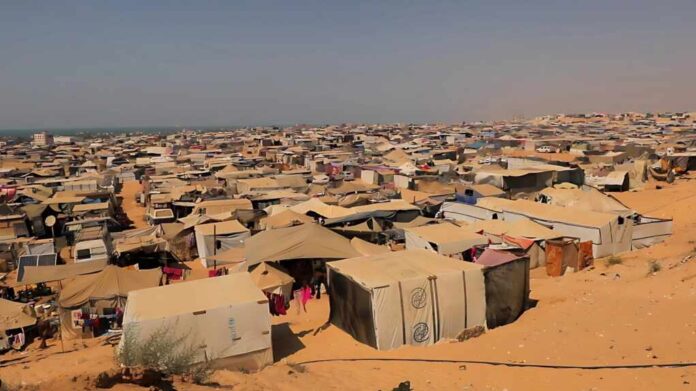
Gaza’s displaced Palestinians face a devastating winter crisis as the first major rains destroy makeshift shelters, exposing the failure of international aid efforts to protect nearly half a million people.
Story Highlights
- 425,000 displaced Palestinians in Muwasi camp devastated by first winter storms, with tarpaulin shelters completely destroyed
- Families forced into dangerous partially-collapsed buildings as makeshift trenches fail to prevent flooding
- International aid organizations admit winterization materials are grossly inadequate for the scale of displacement
- Crisis compounds two years of conflict-driven destruction, leaving 90% of Gaza’s population without proper shelter
Winter Storm Devastates Gaza’s Largest Displacement Camp
The November 15 winter storm struck Gaza’s Muwasi camp with devastating force, flooding tent settlements housing up to 425,000 displaced Palestinians. Water cascaded through the sprawling makeshift community, destroying tarpaulin shelters and soaking families’ remaining belongings. The storm exposed the complete inadequacy of temporary housing solutions that have housed displaced civilians since the October 2023 conflict began. Families desperately dug trenches around their shelters, but the improvised drainage systems proved useless against the seasonal downpour.
Watch: First major rains pummel Gaza and flood tents of displaced Palestinians • FRANCE 24 English
Dangerous Shelter Conditions Force Impossible Choices
Displaced families now face life-threatening decisions as their destroyed tents offer no protection from continuing winter weather. Many have moved into partially destroyed buildings that risk structural collapse, choosing potential death from falling debris over certain exposure to harsh elements. The makeshift shelters, constructed from plastic sheets and tarpaulins, were never designed to withstand Gaza’s winter conditions. Children, elderly residents, and disabled individuals face the highest risk as temperatures drop and more storms approach the region.
First strong winter rains soak Gaza’s makeshift shelters https://t.co/mmWYQrHV4E
— The Hill (@thehill) November 16, 2025
Aid Distribution System Fails Massive Displacement Crisis
International humanitarian organizations acknowledge their winterization efforts cannot meet the unprecedented scale of need across Gaza. Israeli authorities claim they permit entry of winter materials, but aid groups report these supplies reach only a fraction of displaced families. The distribution system struggles with logistical challenges created by ongoing security restrictions and damaged infrastructure. Current relief efforts address less than 10% of the actual need, leaving hundreds of thousands of people exposed to life-threatening weather conditions throughout the winter season.
Infrastructure Destruction Compounds Weather Vulnerability
Two years of conflict have destroyed Gaza’s drainage systems, housing stock, and utilities, creating conditions where seasonal rains become humanitarian disasters. The designated “safe zones” like Muwasi lack basic infrastructure including proper sewage systems, electrical networks, or weatherproof construction materials. Previous displacement camps had some permanent structures, but current tent cities offer zero protection from environmental extremes. This infrastructure deficit means every winter storm will continue causing mass displacement and potential casualties among Gaza’s vulnerable civilian population.
The crisis demonstrates how prolonged conflict creates cascading humanitarian disasters that extend far beyond immediate military operations. Gaza’s displaced population will face months of additional winter weather with inadequate shelter, insufficient aid, and no prospect for infrastructure repair until broader political solutions emerge.
Sources:
First major winter rains pummel Gaza, destroying makeshift shelters – Arab News
First storm of the season pummels Gaza, flooding tent camps and makeshift shelters – Times of Israel

























